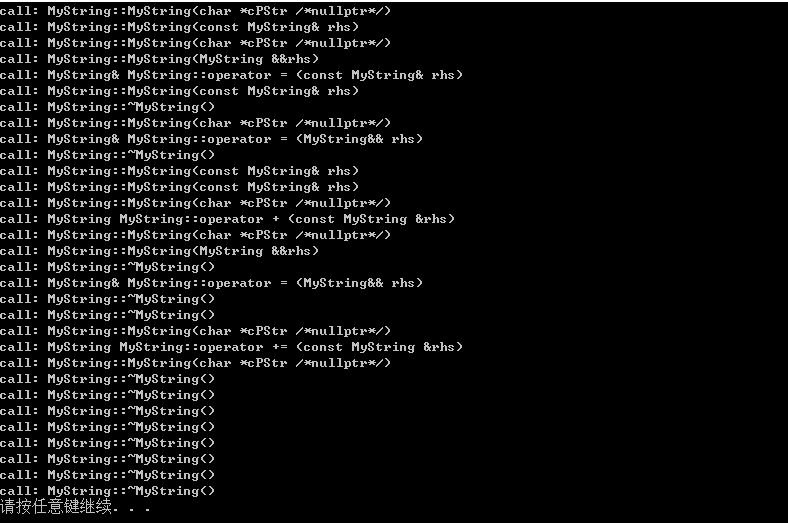学习了博主的《漫谈继承技术》系列博文之后,相信大家都有所收获吧!这次博主将和大家一起探讨 《灵活而奇特的C++语言特性》 ,主要包括引用、常量(const)、常量表达式(constexpr)、静态(static)、外部(expert)、类型定义(typedef)、类型别名(aliases)、类型转换、作用域解析、统一初始化、显示转换运算符、特性(attribute)、用户自定义文本、头文件、可变长度参数列表和预处理器宏。尽管这个知识清单显得有点凌乱,但是这些话题都是博主经过精心挑选,是容易混淆的语言特性。本篇我们来继续学习一下引用,增进大家对《灵活而奇特的C++语言特性》的理解。
经过上一篇博文的学习,相信大家对引用已经掌握的差不多了吧!接下来我们一起来继续探讨引用的其他特性,本篇主要围绕右值引用和移动语义展开。关于移动语义的讲解,博主封装了一个异常安全的MyString类,简单的模拟了一下string的封装,希望对大家对《灵活而奇特的C++语言特性》的学习和掌握有一点帮助。
了解过C++11新特性的小伙伴们一定听说过移动语义,而移动语义要用到一种新的语法,就是右值引用。在C++中,左值是可以获取其地址的一个量,例如一个有名称的变量。由于经常出现在赋值语句的左边,因此将其称为左值。回顾左值的概念后,相信大家已经猜到什么是右值了。对,所有不是左值的量都是右值,例如常量值、临时对象或临时值。而右值引用就是一个对右值的引用。上面的描述可能对于初学者显得有点抽象,咱们来举个栗子吧。
#include<iostream>
usingnamespacestd;
//参数为左值引用
void increace(int&nValue)
{
++nValue;
cout<<"void increace(int &nValue)"<< endl;
}
//参数为右值引用
void increace(int&&nValue)
{
++nValue;
cout<<"void increace(int &&nValue)"<< endl;
}
int main(intargc,char**argv)
{
intnValue = 10;
constintnCValue = 20;
//调用参数为左值引用的increace函数
increace(nValue);
//调用参数为右值引用的increace函数
increace(30);
//常量值可以作为右值引用的参数,然而常量不可以
//increace(nCValue); //error
cout<<"nValue: "<< nValue << endl;
cout<<"nCValue: "<< nCValue << endl;
return0;
}
程序运行结果:
知道了右值引用,那移动语义又是怎么回事呢?咱们来写一个自己的MyString类来体验一下吧。
#define_CRT_SECURE_NO_WARNINGS
#include<iostream>
#include<vector>
usingnamespacestd;
//封装MyString类实现string类的功能
classMyString
{
public:
MyString(constchar*cPStr =nullptr);
virtual~MyString();
MyString(constMyString &rhs);
MyString(MyString &&rhs);
MyString& operator = (constMyString &rhs);
MyString& operator = (MyString&&rhs);
MyString operator + (const MyString &rhs);
MyString& operator += (constMyString &rhs);
private:
char*m_cPStr;
};
MyString::MyString(constchar*cPStr/*nullptr*/)
{
cout<<"call: MyString::MyString(char *cPStr/*nullptr*/)" << endl;
if(nullptr== cPStr)
{
m_cPStr=new char[1];
*m_cPStr='\0';
}
else
{
//求参数对象数据成员字符串长度(加1是为了保存'\0')
constintsize = strlen(cPStr) + 1;
m_cPStr=new char[size];
//内存拷贝
memcpy(m_cPStr,cPStr,size);
}
}
MyString::~MyString()
{
cout<<"call: MyString::~MyString()"<< endl;
if(nullptr!= m_cPStr)
{
delete[]m_cPStr;
m_cPStr=nullptr;
}
}
MyString::MyString(constMyString&rhs)
{
cout<<"call: MyString::MyString(const MyString&rhs)" << endl;
//求参数对象数据成员字符串长度(加1是为了保存'\0')
constintsize = strlen(rhs.m_cPStr) + 1;
m_cPStr =newchar[size];
//内存拷贝
memcpy(m_cPStr,rhs.m_cPStr,size);
}
MyString&MyString::operator= (constMyString&rhs)
{
cout<<"call: MyString& MyString::operator = (constMyString& rhs)" << endl;
//当自己给自己赋值时,直接返回当前对象
if(this== &rhs)
{
return*this;
}
//此处调用拷贝构造函数创建局部对象,当函数结束时该对象被销毁
MyString str(rhs);
//利用局部对象在离开语句块会被销毁的特性,编写异常安全的代码
char*cTemp = m_cPStr;
m_cPStr =str.m_cPStr;
str.m_cPStr= cTemp;
return*this;
}
MyString::MyString(MyString &&rhs)
{
cout<<"call: MyString::MyString(MyString&&rhs)" << endl;
//将右值对象数据成员在堆上的内存赋值给当前对象的数据成员
m_cPStr =rhs.m_cPStr;
//将右值对象数据成员赋为nullptr
rhs.m_cPStr= nullptr;
}
MyString&MyString::operator= (MyString&&rhs)
{
cout<<"call: MyString& MyString::operator =(MyString&& rhs)" << endl;
//当自己给自己赋值时,直接返回当前对象
if(this== &rhs)
{
return*this;
}
//释放左值对象在堆上的内存
if(nullptr!= m_cPStr)
{
delete[]m_cPStr;
}
//将右值对象数据成员在堆上的内存赋值给当前对象的数据成员
m_cPStr =rhs.m_cPStr;
//将右值对象数据成员赋为nullptr
rhs.m_cPStr= nullptr;
return*this;
}
MyStringMyString::operator+ (constMyString&rhs)
{
constintsize = strlen(m_cPStr) + strlen(rhs.m_cPStr)+ 1;
char*cPstr = new char[size];
strcpy(cPstr,m_cPStr);
strcat(cPstr,rhs.m_cPStr);
MyString str(cPstr);
delete[]cPstr;
cPstr =nullptr;
returnstr;
}
MyString&MyString::operator+= (constMyString&rhs)
{
constintsize = strlen(m_cPStr) + strlen(rhs.m_cPStr)+ 1;
char*cPstr = new char[size];
strcpy(cPstr,m_cPStr);
strcat(cPstr,rhs.m_cPStr);
MyString str(cPstr);
delete[]cPstr;
cPstr =nullptr;
char*cPTemp = str.m_cPStr;
str.m_cPStr= m_cPStr;
m_cPStr =cPTemp;
return*this;
}
int main(intargc,char**argv)
{
//创建矢量
vector<MyString>vArray;
//调用构造函数创建对象
MyString str1("string1");
//调用拷贝构造函数创建对象
MyString str2(str1);
//调用构造函数创建临时对象(编译器会做优化,将临时对象直接作为str3)
MyString str3 = MyString("string2");
//使用std::move()将左值转换为右值,此处调用移动构造函数创建对象
MyString str4(std::move(str1));
//调用复制赋值运算符
str2 =str3;
//先调用构造函数创建临时对象,再调用移动赋值运算符
str3 =MyString("string3");
vArray.reserve(2);
vArray.push_back(str2);
vArray.push_back(str3);
//先调用operator+,再调用operator=
str3 =str2 +"string4";
//调用operator+=
str3 +="string5";
return0;
}
程序运行结果:
下面我们来逐条分析一下上面的运行结果:
1) call: MyString::MyString(char*cPStr /*nullptr*/)
MyStringstr1("string1"); //调用构造函数创建对象str1
2) call: MyString::MyString(constMyString& rhs)
MyString str2(str1); //调用拷贝构造函数创建对象str2
3) call: MyString::MyString(char*cPStr /*nullptr*/)
MyString str3 =MyString("string2"); //调用构造函数创建对象str3(由于编译器做了优化,将str3和“=”右边的临时对象作为一个对象来创建)
4) call:MyString::MyString(MyString &&rhs)
MyString str4(std::move(str1)); //std::move(str1)将str1由左值转换为右值,调用移动构造函数创建对象str4
5) call: MyString&MyString::operator = (const MyString& rhs)
str2= str3; //调用复制赋值运算符
6) call: MyString::MyString(constMyString& rhs)
str2= str3; //在复制赋值运算符中“MyString str(rhs);”调用拷贝构造函数创建局部对象
7) call: MyString::~MyString()
str2= str3; //复制赋值运算符调用结束后,局部对象被销毁,调用析构函数
8) call: MyString::MyString(char*cPStr /*nullptr*/)
str3= MyString("string3"); //创建“=”右边的临时对象,调用构造函数
9) call: MyString&MyString::operator = (MyString&& rhs)
str3= MyString("string3"); //由于临时对象是右值,调用移动赋值运算符
10) call: MyString::~MyString()
str3= MyString("string3"); //语句结束后,“=”右边的临时对象被销毁,调用析构函数
11) call: MyString::MyString(constMyString& rhs)
vArray.push_back(str2); //调用拷贝构造函数将str2拷贝到矢量容器中
12) call: MyString::MyString(constMyString& rhs)
vArray.push_back(str3); //调用拷贝构造函数将str3拷贝到矢量容器中
13) call: MyString::MyString(char*cPStr /*nullptr*/)
str3= str2 + "string4"; //调用构造函数创建“+”右边的临时对象
14) call: MyStringMyString::operator + (const MyString &rhs)
str3= str2 + "string4"; //调用operator +函数
15) call: MyString::MyString(char*cPStr /*nullptr*/)
str3= str2 + "string4"; //由于在operator + 函数中“MyString str(cPstr);”创建了临时对象,调用构造函数
16) call:MyString::MyString(MyString &&rhs)
str3= str2 + "string4"; //operator + 函数返回,调用移动构造函数创建返回对象
17) call: MyString::~MyString()
str3= str2 + "string4"; //operator + 函数返回后,函数中创建的临时对象被销毁,调用析构函数
18) call: MyString&MyString::operator = (MyString&& rhs)
str3= str2 + "string4"; //由于“str2+ "string4"”表达式是右值,调用移动赋值运算符
19) call: MyString::~MyString()
str3= str2 + "string4"; //operator + 函数返回的临时对象被销毁,调用析构函数
20) call: MyString::~MyString()
str3= str2 + "string4"; //“+”右边的临时对象被销毁,调用析构函数
21) call: MyString::MyString(char*cPStr /*nullptr*/)
str3+= "string5"; //创建“+=”右边的临时对象,调用构造函数
22) call: MyStringMyString::operator += (const MyString &rhs)
str3+= "string5"; //调用operator +=函数
23) call: MyString::MyString(char*cPStr /*nullptr*/)
str3+= "string5"; //operator +=函数中“MyString str(cPstr);”调用构造函数,创建局部对象
24) call: MyString::~MyString()
str3+= "string5"; //operator +=函数返回后,“MyString str(cPstr);”创建的局部对象被销毁,调用析构函数
25) call: MyString::~MyString()
str3+= "string5"; “+=”右边的临时对象被销毁,调用析构函数
26) call: MyString::~MyString()
vArray中创建的第二个对象被销毁,调用析构函数
27) call: MyString::~MyString()
vArray中创建的地一个对象被销毁,调用析构函数
28) call: MyString::~MyString()
str4被销毁,调用析构函数
29) call: MyString::~MyString()
str3被销毁,调用析构函数
30) call: MyString::~MyString()
str2被销毁,调用析构函数
31) call: MyString::~MyString()
str1被销毁,调用析构函数
上面的代码中有用到std::move()方法,它可以将左值转换为右值,这是我们想用左值调用移动函数的一种方式。移动语义是通过右值引用来实现的。移动构造函数和移动赋值运算符基本上只对成员变量进行表层复制,然后转换已分配内存的所有权,从而阻止悬挂指针和内存泄露。
如果你现在头脑非常清晰,说明你已经掌握了此部分知识,当然你对对象的创建和销毁顺序也掌握的很透彻。如果你还是一脸懵逼,那么就请你先好好复习一下对象的创建和销毁顺序,再回来吧这篇博文仔细的阅览一遍,相信你会有不一样的感受。
如果想了解更多关于C++语言特性相关的知识,请关注博主《灵活而奇特的C++语言特性》系列博文,相信你能够在那里寻找到更多有助你快速成长和加深你对C++语言特性相关的知识和一些特性的理解和掌握。当然,如果你想了解关于继承方面的技术,请关注博主《漫谈继承技术》系列博文。


























 175
175

 被折叠的 条评论
为什么被折叠?
被折叠的 条评论
为什么被折叠?








